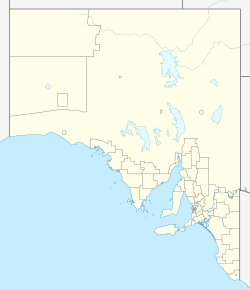Lewis Island (South Australia) facts for kids
| Geography | |
|---|---|
| Location | Spencer Gulf |
| Coordinates | 34°57′20″S 136°01′54″E / 34.95556°S 136.03167°E |
| Administration | |
|
Australia
|
|
Lewis Island is a small island in South Australia. It is found in Spencer Gulf, near the Eyre Peninsula. The island was named by Matthew Flinders in 1802. He named it to remember George Lewis, who was lost at sea. Since 2004, Lewis Island has been a protected area. It is part of the Memory Cove Wilderness Protection Area.
Contents
Exploring Lewis Island
Lewis Island is about 29 km south-east of Port Lincoln. It is also about 926 meters south of Little Island. The island's highest point is 44 meters above the sea. You can get to the island by boat. This is usually done on the north-east coast. It is best to visit when the weather is calm.
How Lewis Island Was Made
Lewis Island was formed about 8,400 years ago. This happened when sea levels rose. The island is made of granite rock. It has a cap of calcarenite on top. Calcarenite is a type of rock made from sand and shells. Unlike other islands nearby, Lewis Island's top is peaked at its southern end. It does not have a flat top. The island rises steeply from the seabed.
Plants and Animals of Lewis Island
Island Plants
In 1996, the island had many shrubs. These were mostly marsh saltbush. This plant grows well in deeper soil. The island also had at least 19 other plant types. These included sea celery and karkalla. Other plants were grey samphire and Australian hollyhock. You could also find native juniper and austral stork's bill. Some weeds, like the African box thorn, also grew there. They may have spread due to past guano mining.
Island Animals and Their Reproduction
In 1996, a group of white-faced storm petrels lived on the island. They were nesting on the higher southern part. Many silver gulls and Pacific gulls were also seen. This suggests they might also breed there. Black-faced shags were seen resting near the water. Reptiles on the island include marbled geckos. There are also four-toed earless skinks and bull skinks. By 2013, Lewis Island was known as a breeding spot for flesh-footed shearwaters.
Ocean Animals
In 1996, people found burrows under the island's rock cap. These burrows suggested that little penguins might have lived there. By 2007, a group of Australian sea lions was reported. They were breeding on the island.
History of Lewis Island
European explorers first saw Lewis Island on February 20, 1802. This was when Matthew Flinders entered what is now Spencer Gulf. He was on his ship, HMS Investigator.
Flinders named the island on February 24, 1802. He named it after George Lewis. George Lewis was one of eight crew members who died. Their small boat, a cutter, turned over. This happened on February 21, 1802, near Cape Catastrophe. They were looking for water.
Past Activities on Lewis Island
Guano Mining
Lewis Island was one of the places where guano was collected. Guano is bird droppings. It was used as fertilizer. People mined guano under a special permit. This happened before 1919. The South Australian Government gave these permits.
Protecting Lewis Island
Lewis Island has been part of the Memory Cove Wilderness Protection Area since 2004. Before that, it was part of the Lincoln National Park. The island first became a protected area in 1965. This was under an old law for protecting animals. The waters around the island are also protected. They are part of the Thorny Passage Marine Park since 2012.


